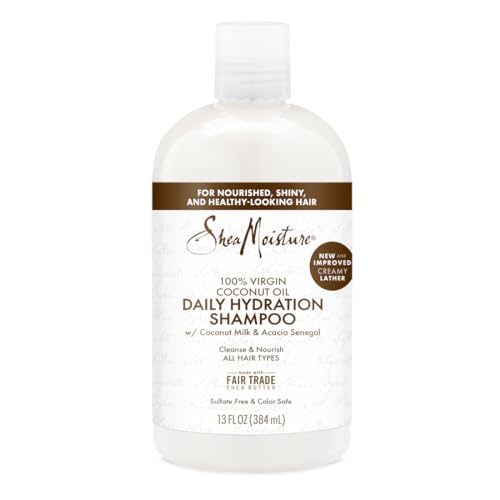
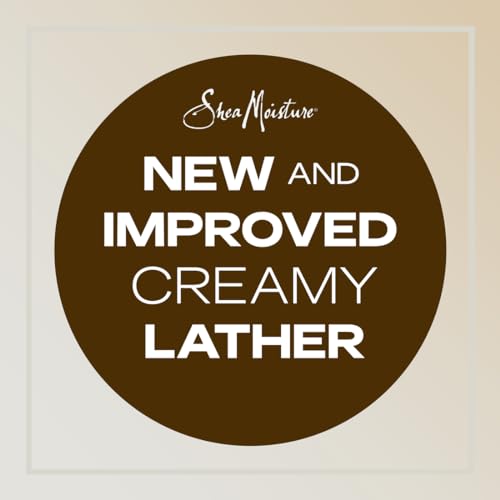
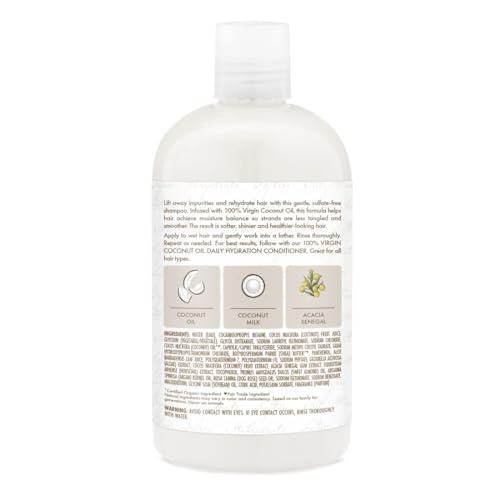
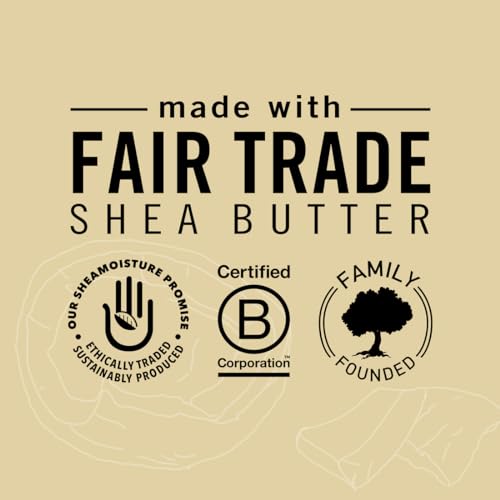
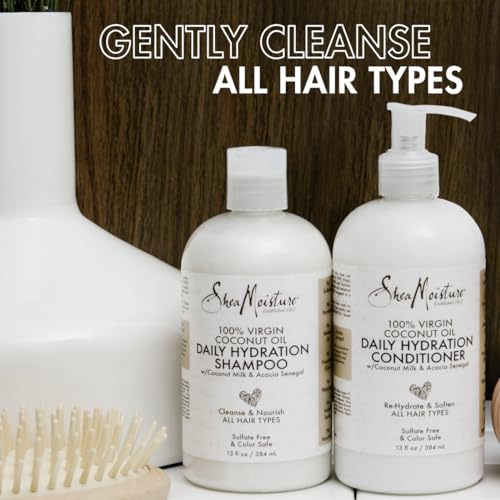
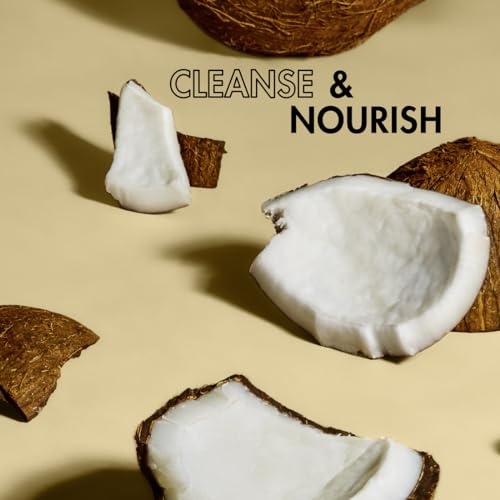


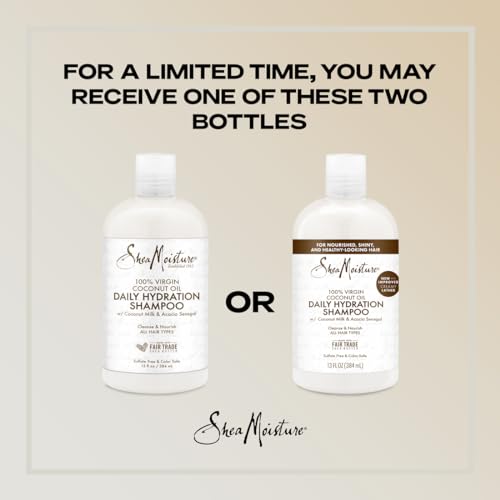
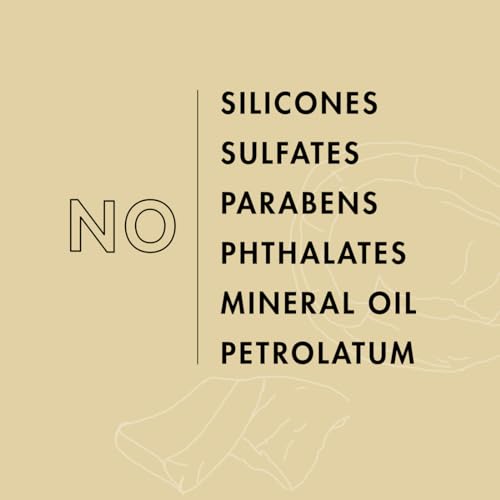
SheaMoisture Virgin Coconut Oil Shampoo - Nourishing, Moisture Balance, Sulfate-Free - 13oz


Fragrance
High RiskFragrance refers to a mixture of aromatic compounds used in products to provide scent. It is commonly listed as 'fragrance' or 'parfum' on product labels and can serve various functions, including enhancing user experience and masking undesirable odors.
Sustai Insights
Fragrance offers functional benefits by improving product appeal; however, it poses significant health risks, notably a high likelihood of causing allergies and allergic contact dermatitis. Environmental risks include potential pollution and endocrine disruption, though its overall carcinogenicity is low. Regulatory bodies have noted concerns regarding its use, leading to a high-risk classification. Safe usage practices should be observed, and alternatives such as natural essential oils are recommended for those sensitive to synthetic fragrances.
Cocamidopropyl Betaine
High RiskCocamidopropyl betaine is a synthetic surfactant derived from coconut oil, commonly used in personal care products for its mild cleansing and foaming properties. It functions as a surfactant, emulsifier, and thickening agent, contributing to the texture and performance of formulations.
Sustai Insights
Cocamidopropyl betaine offers functional benefits as a gentle surfactant, enhancing product foaming and texture. However, it may pose low to moderate allergenic risks and is subject to high use restrictions due to contamination concerns. Regulatory bodies have advised on its safe levels of usage, categorizing its risk level as high overall. Users should practice caution, particularly with sensitive populations, and consider alternatives like naturally derived surfactants for safer formulations.
Sodium Benzoate
Medium RiskSodium benzoate is a preservative commonly used in food and cosmetic products to prevent microbial growth and extend shelf life. It is derived from benzoic acid and is effective at low concentrations, often used in acidic environments like beverages and condiments.
Sustai Insights
Sodium benzoate serves effectively as a preservative, contributing to product stability and safety. It is generally recognized as safe with low concerns for carcinogenicity, allergies, and reproductive toxicity, though it faces moderate use restrictions in some regions. Environmental risks include its potential as a pollutant, but it does not bioaccumulate significantly. Regulatory bodies have issued advisories regarding its concentration in products. Overall, the risk level is assessed as medium, with safe usage practices recommended. Alternatives such as potassium sorbate may provide similar benefits with potentially lower restrictions.
Acacia Senegal Gum Extract
Low RiskAcacia senegal gum extract is an extract derived from the gum of the Acacia senegal tree, commonly used in cosmetics for its thickening and emulsifying properties. It serves to stabilize formulations and improve texture without imparting strong scents or colors.
Sustai Insights
Acacia senegal gum extract offers functional benefits as an effective emulsifier and stabilizer in cosmetic formulations, supporting product texture and stability. It is considered low risk for health concerns such as carcinogenicity, allergies, and developmental toxicity, with no significant environmental hazards reported. Regulatory status indicates no widespread restrictions. Overall, it presents a low risk profile, making it a favorable choice in cosmetic applications.
Sodium Methyl Cocoyl Taurate
Low RiskSodium methyl cocoyl taurate is a sodium salt derived from coconut fatty acids, primarily used as a mild surfactant and foaming agent in personal care products. It helps to cleanse and stabilize formulations, contributing to improved texture and performance.
Sustai Insights
Sodium methyl cocoyl taurate is recognized for its effective surfactant properties, providing gentle cleansing and foam production in formulations. It is considered low risk for health concerns such as carcinogenicity and allergenic potential, with minimal irritation noted. Environmentally, it poses low hazards with no significant bioaccumulation or pollution risks. Regulatory bodies, including ECHA, indicate no current restrictions. Overall, it presents a low risk profile, making it a viable choice in personal care applications. Safe usage practices are recommended, and alternatives may include other mild surfactants.
Equisetum Arvense (Horsetail) Extract
Low RiskEquisetum arvense extract is derived from the horsetail plant, known for its high silica content. It is commonly used in cosmetic formulations for its potential benefits in promoting healthy skin and hair, as well as its role as a natural preservative due to its antioxidant properties.
Sustai Insights
Equisetum arvense extract offers functional benefits including enhancing skin and hair health through its silica content and antioxidant properties. It is sustainably sourced and biodegradable. Health risks are minimal, with low concerns for carcinogenicity, allergies, and reproductive toxicity. Environmental risks are also low, with no significant pollutant or bioaccumulative effects noted. Regulatory bodies do not list this ingredient as restricted. Overall, the risk level is assessed as low, making it a safe option in cosmetic products.
Sodium Phytate
Low RiskSodium phytate is a complex sodium salt of phytic acid, primarily used in cosmetic formulations as a chelating agent. It helps to stabilize formulations by binding metal ions, which can improve product efficacy and shelf life.
Sustai Insights
Sodium phytate offers functional benefits by enhancing product stability and is considered to have low health risks, with no significant associations with carcinogenicity, allergies, or reproductive toxicity. Environmentally, it poses minimal risks, as it is not considered a pollutant or bioaccumulative. Regulatory status indicates no significant restrictions. Overall, the ingredient is assessed as low risk. However, users should practice safe usage and consider alternatives like other chelating agents if desired.
Polyquatermium 7
Low RiskPolyquaternium-7 is a synthetic polymer commonly used in hair and skin care products for its conditioning and film-forming properties. It helps improve texture, manageability, and moisture retention, making it effective in various formulations, particularly in leave-on products.
Sustai Insights
Polyquaternium-7 offers functional benefits as a conditioning agent and film former, enhancing product texture and moisture retention. It is considered low risk for health concerns like carcinogenicity, allergies, and reproductive toxicity. Environmentally, it poses minimal risks regarding pollution or bioaccumulation. Regulatory assessments do not indicate major restrictions. Safe usage practices should be followed, though alternatives may include more natural conditioning agents. Overall, the ingredient is assessed as low risk.
Argania Spinosa (Argan) Kernel Oil
Low RiskArgania spinosa (argan) kernel oil is a fixed oil extracted from the kernels of the argan tree, native to Morocco. It is commonly used in cosmetic formulations for its moisturizing properties, serving as an emollient and skin conditioner.
Sustai Insights
Argania spinosa kernel oil offers functional benefits such as effective hydration and nourishment for the skin and hair. It is sustainably sourced and biodegradable, contributing positively to environmental considerations. Health risks are low, with minimal concerns regarding carcinogenicity, allergies, or reproductive toxicity. There are no current regulatory restrictions on its use. Overall, it poses low risk, making it a suitable ingredient in cosmetic products. Safe usage practices should be maintained, and alternatives like jojoba oil may also be considered for similar benefits.
Stearamide Amp
Low RiskStearamide AMP is a chemical compound primarily used in various cosmetic and personal care products as an emulsifier and thickening agent. It functions by enhancing the texture and stability of formulations, contributing to the overall performance of the product without imparting any specific benefits or drawbacks.
Sustai Insights
Stearamide AMP serves as an emulsifier and thickening agent, contributing to product stability and texture. It is not associated with significant health risks, including low concerns for carcinogenicity, allergies, or reproductive toxicity. Environmentally, it poses minimal risks as it is not a known pollutant or bioaccumulative. Regulatory bodies do not issue any warnings or restrictions regarding its use, designating it as low risk overall. Safe usage practices are recommended, and alternatives may include more sustainable emulsifiers if desired.
Butyrospermum Parkii (Shea) Butter
Low RiskButyrospermum parkii (shea) butter is a vegetable fat derived from the nuts of the shea tree. It is commonly used in cosmetic formulations for its emollient properties, providing moisture and improving skin texture. Additionally, shea butter is known for its ability to enhance the stability of products and deliver a creamy texture.
Sustai Insights
Shea butter offers functional benefits as an effective moisturizer, enhancing skin barrier function and texture. It is sustainably sourced and biodegradable, contributing to eco-friendliness. Health-wise, it is associated with low risks for carcinogenicity, allergies, and reproductive toxicity. Environmental impacts are minimal, with no significant pollutant potential identified. Regulatory assessments indicate no current restrictions. Overall, the ingredient presents a low risk, making it a favorable choice in cosmetic formulations.
Rosa Canina (Dog Rose) Fruit Oil
Low RiskRosa canina (dog rose) fruit oil is derived from the fruit of the dog rose plant. It is commonly used in cosmetics for its emollient properties, helping to moisturize and soothe the skin. Additionally, it may contain bioactive compounds that contribute to its potential skin benefits.
Sustai Insights
Rosa canina fruit oil offers functional benefits as a moisturizer and skin conditioner, with sustainable sourcing potential. Health risks are low, with minimal concerns regarding carcinogenicity, allergies, or reproductive toxicity. Environmental risks are also low, with no significant pollutant potential. Regulatory agencies do not list it under restrictions, indicating its safety for use. Overall, the risk level is assessed as low, making it a suitable ingredient for cosmetic formulations.
Corylus (Hazelnut) Oil
Low RiskCorylus (hazelnut) oil is derived from the nuts of the hazel tree. It is primarily used in cosmetic and skincare products for its emollient properties, providing moisture and enhancing skin texture. The oil is rich in fatty acids and vitamins, contributing to its function as a skin conditioning agent.
Sustai Insights
Corylus (hazelnut) oil offers functional benefits as a moisturizer and skin conditioner while being biodegradable and potentially sustainably sourced. Health risks are low, with minimal concerns related to carcinogenicity, allergenic potential, or reproductive toxicity. Environmental impacts are also low, with no known bioaccumulation issues. Regulatory status shows no restrictions. Overall, the ingredient is assessed as low risk, with safe usage practices recommended and no significant alternatives noted.
Cocos Nucifera (Coconut) Fruit Juice
Low RiskCocos Nucifera (Coconut) Fruit Juice is a liquid derived from the fruit of the coconut palm, widely used in cosmetic formulations for its moisturizing and soothing properties. It serves as a natural humectant, helping to maintain skin hydration and improve texture in various personal care products.
Sustai Insights
Cocos Nucifera (Coconut) Fruit Juice offers functional benefits such as hydration and skin soothing, making it a beneficial ingredient in cosmetics. It is sustainably sourced and biodegradable, contributing positively to environmental considerations. Health risks are low, with no significant concerns regarding carcinogenicity, allergens, or reproductive toxicity. Regulatory bodies impose few restrictions, and overall risk is assessed as low. Safe usage promotes skin health without notable adverse effects. Alternatives include other fruit juices or plant extracts that offer similar moisturizing properties.
Decyl Glucoside
Low RiskDecyl glucoside is a glucose-based surfactant derived from natural sources, primarily used as a mild cleansing agent in personal care products. It effectively reduces surface tension, allowing for improved mixing of ingredients and enhanced cleansing properties without stripping natural oils from the skin.
Sustai Insights
Decyl glucoside offers functional benefits as a non-ionic surfactant, making it suitable for sensitive skin formulations. It is biodegradable and derived from renewable resources, supporting sustainability. Health risks are primarily low, with minimal concerns regarding irritation and allergies. Environmental risks are low, as it does not significantly contribute to pollution or bioaccumulation. Regulatory status is generally favorable, with low restrictions noted. Overall, decyl glucoside presents a low risk for use in consumer products, making it a suitable choice for gentle formulations.
Caprylic Triglyceride
Low RiskCaprylic triglyceride is an ester derived from coconut oil and glycerin, commonly used in cosmetic formulations as an emollient, stabilizer, and skin-conditioning agent. It helps to improve the texture and spreadability of products while providing a lightweight, non-greasy feel.
Sustai Insights
Caprylic triglyceride offers functional benefits such as enhanced skin moisturization and improved formulation stability. It is generally regarded as safe, with low concerns regarding carcinogenicity, allergenic potential, and reproductive toxicity. Environmental impact is minimal, with no significant pollutant or bioaccumulative properties identified. Regulatory bodies have not issued warnings or restrictions. Overall, the risk level is low, making it a suitable ingredient in cosmetic products. Safe usage practices include adhering to recommended concentrations, and while there are alternatives, caprylic triglyceride remains a reliable choice.
Tocopherol, D Alpha
Low RiskTocopherol, specifically d-alpha tocopherol, is a naturally occurring form of Vitamin E. It is commonly used in cosmetic and personal care products primarily for its antioxidant properties, helping to protect formulations from oxidation and extend shelf life.
Sustai Insights
D-alpha tocopherol provides effective antioxidant benefits, contributing to product stability. It is sustainably sourced and generally regarded as safe, with low concerns regarding carcinogenicity, allergies, and reproductive toxicity. However, there are minor concerns about endocrine disruption. Regulatory bodies have not imposed significant restrictions, indicating low overall risk. Recommended usage practices include adhering to established safe concentration thresholds. Alternatives, such as other forms of Vitamin E or plant-based antioxidants, may also be considered.
Sodium Lauroyl Lactylate
Low RiskSodium lauroyl lactylate is a sodium salt of lauric acid and lactyl lactate, primarily used in cosmetic formulations as an emulsifier and skin conditioning agent. It helps to enhance the texture and stability of products while also promoting skin feel.
Sustai Insights
Sodium lauroyl lactylate is valued for its emulsifying properties, improving product texture and stability. It is considered biodegradable and sustainably sourced, contributing to eco-friendliness. Health risks are low, with minimal concerns regarding carcinogenicity, allergenic potential, and reproductive toxicity. Environmental risks are also low, with no significant bioaccumulation or pollution potential identified. Regulatory bodies have not imposed restrictions on its use. Overall, this ingredient presents a low risk profile, making it a suitable choice for cosmetic formulations.
Caprylyl Glycol
Low RiskCaprylyl glycol (1,2-octanediol) is a multifunctional cosmetic ingredient primarily used as a skin-conditioning agent and preservative. It is derived from caprylic acid, a fatty acid found in coconut oil, and is commonly included in personal care products for its moisturizing properties.
Sustai Insights
Caprylyl glycol offers functional benefits such as acting as an effective humectant and preservative, enhancing skin hydration and product stability. It is considered to have low health risks, with no significant concerns regarding carcinogenicity, allergies, or reproductive toxicity. Environmentally, it poses minimal risks, being non-bioaccumulative and not linked to pollution. Regulatory assessments affirm its safety, with no major advisories against its use. Overall, the ingredient is assessed to have a low risk, making it a suitable choice in cosmetic formulations.
Glycol Distearate
Low RiskGlycol distearate is a compound derived from stearic acid and ethylene glycol, primarily used as an emulsifier and thickening agent in cosmetic formulations. It helps to stabilize emulsions and improve the texture of products, allowing for better application and consistency.
Sustai Insights
Glycol distearate offers functional benefits as an effective emulsifier, enhancing product stability and texture. It is generally regarded as safe, with low concerns regarding carcinogenicity, allergies, and reproductive toxicity. However, attention is warranted regarding cumulative exposure from multiple sources. While it poses minimal health and environmental risks, users should adhere to recommended usage levels. Overall, the risk level is assessed as low, with no significant regulatory warnings or restrictions.
Water
Low RiskWater is a clear, colorless liquid essential for various biological processes. It serves as a solvent in formulations, facilitating the dissolution of other ingredients and enhancing product texture and application. Additionally, water plays a crucial role in hydration and is a key component in many cosmetic and personal care products.
Sustai Insights
Water is an effective solvent and hydrator, contributing to the texture and efficacy of formulations. It is biodegradable and generally regarded as safe, with low concerns regarding carcinogenicity, allergies, and reproductive toxicity. However, excessive water usage can lead to environmental concerns, particularly regarding resource depletion. Regulatory bodies do not impose restrictions on water use in cosmetics. Overall, the risks associated with water are low, making it a safe and essential ingredient.
Coconut Fatty Acid
Low RiskCoconut fatty acid is a mixture of fatty acids derived from coconut oil, primarily composed of caprylic and capric acids. It is commonly used in cosmetic formulations for its emollient properties, helping to moisturize and soften the skin.
Sustai Insights
Coconut fatty acid serves as an effective emollient, enhancing skin hydration and texture. It is considered to have low health risks, with minimal concerns regarding carcinogenicity, allergenic potential, and reproductive toxicity. Environmentally, it is not recognized as a pollutant or bioaccumulative. Regulatory bodies do not impose significant restrictions on its use. Overall, the ingredient poses low risk, and its safe application in cosmetic products is supported by its favorable profile.
Glycol Stearate
Low RiskGlycol stearate is composed of ethylene glycol and stearic acid. It serves primarily as an emulsifier and thickener in cosmetic formulations, helping to stabilize and enhance the texture of products.
Sustai Insights
Glycol stearate exhibits functional benefits as an effective emulsifier, improving product stability and texture. It is generally recognized as having low health risks, with no significant concerns regarding carcinogenicity, allergies, or reproductive toxicity. Environmentally, it poses low risks with no significant pollutant potential or bioaccumulation. Regulatory agencies have not imposed significant restrictions on its use in cosmetics. Overall, it is assessed as low risk, making it a suitable ingredient in formulations. For those seeking alternatives, other natural emulsifiers may be considered.
Cocos Nucifera (Coconut) Oil
Low RiskCocos Nucifera (Coconut) Oil is derived from the kernels of the coconut palm. It is primarily used in cosmetic formulations for its emollient and moisturizing properties, making it suitable for skin and hair care products.
Sustai Insights
Coconut oil serves as an effective moisturizer and emollient, promoting skin hydration and softness. It is sustainably sourced and biodegradable. Health risks are minimal, with low concerns regarding carcinogenicity, allergens, and reproductive toxicity. Environmental impact is also low, as it does not contribute significantly to pollution or bioaccumulation. Regulatory bodies have not issued restrictions on its use. Overall, coconut oil presents a low risk for health and environmental concerns, making it a safe ingredient in cosmetic products.
Guar Hydroxypropyltrimonium Chloride
Low RiskGuar hydroxypropyltrimonium chloride is a quaternary ammonium compound derived from guar gum, primarily used as a conditioning agent in cosmetic products. It enhances the texture and feel of hair and skin formulations, providing moisture retention and improved manageability.
Sustai Insights
This ingredient offers functional benefits as a conditioning agent, improving the texture and moisture retention in formulations. It is considered low risk regarding health effects, with minimal concerns for carcinogenicity, allergies, or reproductive toxicity. Environmental risks are also low, as it does not accumulate significantly in ecosystems. Regulatory bodies have not imposed significant restrictions. Safe usage practices should be followed, but overall, this ingredient is assessed as low risk, with no immediate concerns regarding alternatives.
Sodium Cocoyl Isethionate
Low RiskSodium cocoyl isethionate is a surfactant derived from coconut oil, commonly used in cosmetic formulations. It functions as a cleansing and foaming agent, contributing to the texture and effectiveness of personal care products such as shampoos and body washes. It helps to remove dirt and oils from the skin and hair.
Sustai Insights
Sodium cocoyl isethionate offers functional benefits as a gentle surfactant that effectively cleanses without stripping moisture. It is biodegradable and derived from renewable sources, enhancing its sustainability profile. Health risks are low, with minimal potential for irritation or allergies noted. Regulatory bodies have not imposed significant restrictions, indicating a favorable risk assessment overall. Usage should be within recommended concentrations to maintain safety. Alternatives include milder surfactants like decyl glucoside for those seeking gentler options. Overall, the ingredient is assessed to have a low risk.
Panthenol, D
Low RiskPanthenol, also known as provitamin B5, is a humectant commonly used in cosmetic and personal care products. It functions primarily as a moisturizer, enhancing skin hydration and improving the appearance of hair by imparting shine and softness.
Sustai Insights
Panthenol is effective in retaining moisture, thus providing functional benefits for skin and hair care products. It is generally recognized as safe, with low concerns regarding carcinogenicity, allergies, and developmental toxicity. However, potential cumulative exposure from multiple sources exists. Environmental risks are minimal, and it is not bioaccumulative. Regulatory bodies have not issued significant warnings; therefore, the overall risk level is assessed as low. For optimal use, it is recommended to follow product guidelines, and alternatives such as glycerin may also be considered for moisturizing effects.
Acacia Senegal Gum Extract
Low RiskAcacia senegal gum extract is an extract derived from the gum of the Acacia senegal tree, commonly used in cosmetics for its thickening and emulsifying properties. It serves to stabilize formulations and improve texture without imparting strong scents or colors.
Sustai Insights
Acacia senegal gum extract offers functional benefits as an effective emulsifier and stabilizer in cosmetic formulations, supporting product texture and stability. It is considered low risk for health concerns such as carcinogenicity, allergies, and developmental toxicity, with no significant environmental hazards reported. Regulatory status indicates no widespread restrictions. Overall, it presents a low risk profile, making it a favorable choice in cosmetic applications.
Sodium Methyl Cocoyl Taurate
Low RiskSodium methyl cocoyl taurate is a sodium salt derived from coconut fatty acids, primarily used as a mild surfactant and foaming agent in personal care products. It helps to cleanse and stabilize formulations, contributing to improved texture and performance.
Sustai Insights
Sodium methyl cocoyl taurate is recognized for its effective surfactant properties, providing gentle cleansing and foam production in formulations. It is considered low risk for health concerns such as carcinogenicity and allergenic potential, with minimal irritation noted. Environmentally, it poses low hazards with no significant bioaccumulation or pollution risks. Regulatory bodies, including ECHA, indicate no current restrictions. Overall, it presents a low risk profile, making it a viable choice in personal care applications. Safe usage practices are recommended, and alternatives may include other mild surfactants.
Fragrance
High RiskFragrance refers to a mixture of aromatic compounds used in products to provide scent. It is commonly listed as 'fragrance' or 'parfum' on product labels and can serve various functions, including enhancing user experience and masking undesirable odors.
Sustai Insights
Fragrance offers functional benefits by improving product appeal; however, it poses significant health risks, notably a high likelihood of causing allergies and allergic contact dermatitis. Environmental risks include potential pollution and endocrine disruption, though its overall carcinogenicity is low. Regulatory bodies have noted concerns regarding its use, leading to a high-risk classification. Safe usage practices should be observed, and alternatives such as natural essential oils are recommended for those sensitive to synthetic fragrances.
Equisetum Arvense (Horsetail) Extract
Low RiskEquisetum arvense extract is derived from the horsetail plant, known for its high silica content. It is commonly used in cosmetic formulations for its potential benefits in promoting healthy skin and hair, as well as its role as a natural preservative due to its antioxidant properties.
Sustai Insights
Equisetum arvense extract offers functional benefits including enhancing skin and hair health through its silica content and antioxidant properties. It is sustainably sourced and biodegradable. Health risks are minimal, with low concerns for carcinogenicity, allergies, and reproductive toxicity. Environmental risks are also low, with no significant pollutant or bioaccumulative effects noted. Regulatory bodies do not list this ingredient as restricted. Overall, the risk level is assessed as low, making it a safe option in cosmetic products.
Sodium Phytate
Low RiskSodium phytate is a complex sodium salt of phytic acid, primarily used in cosmetic formulations as a chelating agent. It helps to stabilize formulations by binding metal ions, which can improve product efficacy and shelf life.
Sustai Insights
Sodium phytate offers functional benefits by enhancing product stability and is considered to have low health risks, with no significant associations with carcinogenicity, allergies, or reproductive toxicity. Environmentally, it poses minimal risks, as it is not considered a pollutant or bioaccumulative. Regulatory status indicates no significant restrictions. Overall, the ingredient is assessed as low risk. However, users should practice safe usage and consider alternatives like other chelating agents if desired.
Cocamidopropyl Betaine
High RiskCocamidopropyl betaine is a synthetic surfactant derived from coconut oil, commonly used in personal care products for its mild cleansing and foaming properties. It functions as a surfactant, emulsifier, and thickening agent, contributing to the texture and performance of formulations.
Sustai Insights
Cocamidopropyl betaine offers functional benefits as a gentle surfactant, enhancing product foaming and texture. However, it may pose low to moderate allergenic risks and is subject to high use restrictions due to contamination concerns. Regulatory bodies have advised on its safe levels of usage, categorizing its risk level as high overall. Users should practice caution, particularly with sensitive populations, and consider alternatives like naturally derived surfactants for safer formulations.
Polyquatermium 7
Low RiskPolyquaternium-7 is a synthetic polymer commonly used in hair and skin care products for its conditioning and film-forming properties. It helps improve texture, manageability, and moisture retention, making it effective in various formulations, particularly in leave-on products.
Sustai Insights
Polyquaternium-7 offers functional benefits as a conditioning agent and film former, enhancing product texture and moisture retention. It is considered low risk for health concerns like carcinogenicity, allergies, and reproductive toxicity. Environmentally, it poses minimal risks regarding pollution or bioaccumulation. Regulatory assessments do not indicate major restrictions. Safe usage practices should be followed, though alternatives may include more natural conditioning agents. Overall, the ingredient is assessed as low risk.
Argania Spinosa (Argan) Kernel Oil
Low RiskArgania spinosa (argan) kernel oil is a fixed oil extracted from the kernels of the argan tree, native to Morocco. It is commonly used in cosmetic formulations for its moisturizing properties, serving as an emollient and skin conditioner.
Sustai Insights
Argania spinosa kernel oil offers functional benefits such as effective hydration and nourishment for the skin and hair. It is sustainably sourced and biodegradable, contributing positively to environmental considerations. Health risks are low, with minimal concerns regarding carcinogenicity, allergies, or reproductive toxicity. There are no current regulatory restrictions on its use. Overall, it poses low risk, making it a suitable ingredient in cosmetic products. Safe usage practices should be maintained, and alternatives like jojoba oil may also be considered for similar benefits.
Stearamide Amp
Low RiskStearamide AMP is a chemical compound primarily used in various cosmetic and personal care products as an emulsifier and thickening agent. It functions by enhancing the texture and stability of formulations, contributing to the overall performance of the product without imparting any specific benefits or drawbacks.
Sustai Insights
Stearamide AMP serves as an emulsifier and thickening agent, contributing to product stability and texture. It is not associated with significant health risks, including low concerns for carcinogenicity, allergies, or reproductive toxicity. Environmentally, it poses minimal risks as it is not a known pollutant or bioaccumulative. Regulatory bodies do not issue any warnings or restrictions regarding its use, designating it as low risk overall. Safe usage practices are recommended, and alternatives may include more sustainable emulsifiers if desired.
Butyrospermum Parkii (Shea) Butter
Low RiskButyrospermum parkii (shea) butter is a vegetable fat derived from the nuts of the shea tree. It is commonly used in cosmetic formulations for its emollient properties, providing moisture and improving skin texture. Additionally, shea butter is known for its ability to enhance the stability of products and deliver a creamy texture.
Sustai Insights
Shea butter offers functional benefits as an effective moisturizer, enhancing skin barrier function and texture. It is sustainably sourced and biodegradable, contributing to eco-friendliness. Health-wise, it is associated with low risks for carcinogenicity, allergies, and reproductive toxicity. Environmental impacts are minimal, with no significant pollutant potential identified. Regulatory assessments indicate no current restrictions. Overall, the ingredient presents a low risk, making it a favorable choice in cosmetic formulations.
Rosa Canina (Dog Rose) Fruit Oil
Low RiskRosa canina (dog rose) fruit oil is derived from the fruit of the dog rose plant. It is commonly used in cosmetics for its emollient properties, helping to moisturize and soothe the skin. Additionally, it may contain bioactive compounds that contribute to its potential skin benefits.
Sustai Insights
Rosa canina fruit oil offers functional benefits as a moisturizer and skin conditioner, with sustainable sourcing potential. Health risks are low, with minimal concerns regarding carcinogenicity, allergies, or reproductive toxicity. Environmental risks are also low, with no significant pollutant potential. Regulatory agencies do not list it under restrictions, indicating its safety for use. Overall, the risk level is assessed as low, making it a suitable ingredient for cosmetic formulations.
Corylus (Hazelnut) Oil
Low RiskCorylus (hazelnut) oil is derived from the nuts of the hazel tree. It is primarily used in cosmetic and skincare products for its emollient properties, providing moisture and enhancing skin texture. The oil is rich in fatty acids and vitamins, contributing to its function as a skin conditioning agent.
Sustai Insights
Corylus (hazelnut) oil offers functional benefits as a moisturizer and skin conditioner while being biodegradable and potentially sustainably sourced. Health risks are low, with minimal concerns related to carcinogenicity, allergenic potential, or reproductive toxicity. Environmental impacts are also low, with no known bioaccumulation issues. Regulatory status shows no restrictions. Overall, the ingredient is assessed as low risk, with safe usage practices recommended and no significant alternatives noted.
Sodium Benzoate
Medium RiskSodium benzoate is a preservative commonly used in food and cosmetic products to prevent microbial growth and extend shelf life. It is derived from benzoic acid and is effective at low concentrations, often used in acidic environments like beverages and condiments.
Sustai Insights
Sodium benzoate serves effectively as a preservative, contributing to product stability and safety. It is generally recognized as safe with low concerns for carcinogenicity, allergies, and reproductive toxicity, though it faces moderate use restrictions in some regions. Environmental risks include its potential as a pollutant, but it does not bioaccumulate significantly. Regulatory bodies have issued advisories regarding its concentration in products. Overall, the risk level is assessed as medium, with safe usage practices recommended. Alternatives such as potassium sorbate may provide similar benefits with potentially lower restrictions.
Cocos Nucifera (Coconut) Fruit Juice
Low RiskCocos Nucifera (Coconut) Fruit Juice is a liquid derived from the fruit of the coconut palm, widely used in cosmetic formulations for its moisturizing and soothing properties. It serves as a natural humectant, helping to maintain skin hydration and improve texture in various personal care products.
Sustai Insights
Cocos Nucifera (Coconut) Fruit Juice offers functional benefits such as hydration and skin soothing, making it a beneficial ingredient in cosmetics. It is sustainably sourced and biodegradable, contributing positively to environmental considerations. Health risks are low, with no significant concerns regarding carcinogenicity, allergens, or reproductive toxicity. Regulatory bodies impose few restrictions, and overall risk is assessed as low. Safe usage promotes skin health without notable adverse effects. Alternatives include other fruit juices or plant extracts that offer similar moisturizing properties.
Decyl Glucoside
Low RiskDecyl glucoside is a glucose-based surfactant derived from natural sources, primarily used as a mild cleansing agent in personal care products. It effectively reduces surface tension, allowing for improved mixing of ingredients and enhanced cleansing properties without stripping natural oils from the skin.
Sustai Insights
Decyl glucoside offers functional benefits as a non-ionic surfactant, making it suitable for sensitive skin formulations. It is biodegradable and derived from renewable resources, supporting sustainability. Health risks are primarily low, with minimal concerns regarding irritation and allergies. Environmental risks are low, as it does not significantly contribute to pollution or bioaccumulation. Regulatory status is generally favorable, with low restrictions noted. Overall, decyl glucoside presents a low risk for use in consumer products, making it a suitable choice for gentle formulations.
Caprylic Triglyceride
Low RiskCaprylic triglyceride is an ester derived from coconut oil and glycerin, commonly used in cosmetic formulations as an emollient, stabilizer, and skin-conditioning agent. It helps to improve the texture and spreadability of products while providing a lightweight, non-greasy feel.
Sustai Insights
Caprylic triglyceride offers functional benefits such as enhanced skin moisturization and improved formulation stability. It is generally regarded as safe, with low concerns regarding carcinogenicity, allergenic potential, and reproductive toxicity. Environmental impact is minimal, with no significant pollutant or bioaccumulative properties identified. Regulatory bodies have not issued warnings or restrictions. Overall, the risk level is low, making it a suitable ingredient in cosmetic products. Safe usage practices include adhering to recommended concentrations, and while there are alternatives, caprylic triglyceride remains a reliable choice.
Tocopherol, D Alpha
Low RiskTocopherol, specifically d-alpha tocopherol, is a naturally occurring form of Vitamin E. It is commonly used in cosmetic and personal care products primarily for its antioxidant properties, helping to protect formulations from oxidation and extend shelf life.
Sustai Insights
D-alpha tocopherol provides effective antioxidant benefits, contributing to product stability. It is sustainably sourced and generally regarded as safe, with low concerns regarding carcinogenicity, allergies, and reproductive toxicity. However, there are minor concerns about endocrine disruption. Regulatory bodies have not imposed significant restrictions, indicating low overall risk. Recommended usage practices include adhering to established safe concentration thresholds. Alternatives, such as other forms of Vitamin E or plant-based antioxidants, may also be considered.
Sodium Lauroyl Lactylate
Low RiskSodium lauroyl lactylate is a sodium salt of lauric acid and lactyl lactate, primarily used in cosmetic formulations as an emulsifier and skin conditioning agent. It helps to enhance the texture and stability of products while also promoting skin feel.
Sustai Insights
Sodium lauroyl lactylate is valued for its emulsifying properties, improving product texture and stability. It is considered biodegradable and sustainably sourced, contributing to eco-friendliness. Health risks are low, with minimal concerns regarding carcinogenicity, allergenic potential, and reproductive toxicity. Environmental risks are also low, with no significant bioaccumulation or pollution potential identified. Regulatory bodies have not imposed restrictions on its use. Overall, this ingredient presents a low risk profile, making it a suitable choice for cosmetic formulations.
Caprylyl Glycol
Low RiskCaprylyl glycol (1,2-octanediol) is a multifunctional cosmetic ingredient primarily used as a skin-conditioning agent and preservative. It is derived from caprylic acid, a fatty acid found in coconut oil, and is commonly included in personal care products for its moisturizing properties.
Sustai Insights
Caprylyl glycol offers functional benefits such as acting as an effective humectant and preservative, enhancing skin hydration and product stability. It is considered to have low health risks, with no significant concerns regarding carcinogenicity, allergies, or reproductive toxicity. Environmentally, it poses minimal risks, being non-bioaccumulative and not linked to pollution. Regulatory assessments affirm its safety, with no major advisories against its use. Overall, the ingredient is assessed to have a low risk, making it a suitable choice in cosmetic formulations.
Glycol Distearate
Low RiskGlycol distearate is a compound derived from stearic acid and ethylene glycol, primarily used as an emulsifier and thickening agent in cosmetic formulations. It helps to stabilize emulsions and improve the texture of products, allowing for better application and consistency.
Sustai Insights
Glycol distearate offers functional benefits as an effective emulsifier, enhancing product stability and texture. It is generally regarded as safe, with low concerns regarding carcinogenicity, allergies, and reproductive toxicity. However, attention is warranted regarding cumulative exposure from multiple sources. While it poses minimal health and environmental risks, users should adhere to recommended usage levels. Overall, the risk level is assessed as low, with no significant regulatory warnings or restrictions.
Water
Low RiskWater is a clear, colorless liquid essential for various biological processes. It serves as a solvent in formulations, facilitating the dissolution of other ingredients and enhancing product texture and application. Additionally, water plays a crucial role in hydration and is a key component in many cosmetic and personal care products.
Sustai Insights
Water is an effective solvent and hydrator, contributing to the texture and efficacy of formulations. It is biodegradable and generally regarded as safe, with low concerns regarding carcinogenicity, allergies, and reproductive toxicity. However, excessive water usage can lead to environmental concerns, particularly regarding resource depletion. Regulatory bodies do not impose restrictions on water use in cosmetics. Overall, the risks associated with water are low, making it a safe and essential ingredient.
Coconut Fatty Acid
Low RiskCoconut fatty acid is a mixture of fatty acids derived from coconut oil, primarily composed of caprylic and capric acids. It is commonly used in cosmetic formulations for its emollient properties, helping to moisturize and soften the skin.
Sustai Insights
Coconut fatty acid serves as an effective emollient, enhancing skin hydration and texture. It is considered to have low health risks, with minimal concerns regarding carcinogenicity, allergenic potential, and reproductive toxicity. Environmentally, it is not recognized as a pollutant or bioaccumulative. Regulatory bodies do not impose significant restrictions on its use. Overall, the ingredient poses low risk, and its safe application in cosmetic products is supported by its favorable profile.
Glycol Stearate
Low RiskGlycol stearate is composed of ethylene glycol and stearic acid. It serves primarily as an emulsifier and thickener in cosmetic formulations, helping to stabilize and enhance the texture of products.
Sustai Insights
Glycol stearate exhibits functional benefits as an effective emulsifier, improving product stability and texture. It is generally recognized as having low health risks, with no significant concerns regarding carcinogenicity, allergies, or reproductive toxicity. Environmentally, it poses low risks with no significant pollutant potential or bioaccumulation. Regulatory agencies have not imposed significant restrictions on its use in cosmetics. Overall, it is assessed as low risk, making it a suitable ingredient in formulations. For those seeking alternatives, other natural emulsifiers may be considered.
Cocos Nucifera (Coconut) Oil
Low RiskCocos Nucifera (Coconut) Oil is derived from the kernels of the coconut palm. It is primarily used in cosmetic formulations for its emollient and moisturizing properties, making it suitable for skin and hair care products.
Sustai Insights
Coconut oil serves as an effective moisturizer and emollient, promoting skin hydration and softness. It is sustainably sourced and biodegradable. Health risks are minimal, with low concerns regarding carcinogenicity, allergens, and reproductive toxicity. Environmental impact is also low, as it does not contribute significantly to pollution or bioaccumulation. Regulatory bodies have not issued restrictions on its use. Overall, coconut oil presents a low risk for health and environmental concerns, making it a safe ingredient in cosmetic products.
Guar Hydroxypropyltrimonium Chloride
Low RiskGuar hydroxypropyltrimonium chloride is a quaternary ammonium compound derived from guar gum, primarily used as a conditioning agent in cosmetic products. It enhances the texture and feel of hair and skin formulations, providing moisture retention and improved manageability.
Sustai Insights
This ingredient offers functional benefits as a conditioning agent, improving the texture and moisture retention in formulations. It is considered low risk regarding health effects, with minimal concerns for carcinogenicity, allergies, or reproductive toxicity. Environmental risks are also low, as it does not accumulate significantly in ecosystems. Regulatory bodies have not imposed significant restrictions. Safe usage practices should be followed, but overall, this ingredient is assessed as low risk, with no immediate concerns regarding alternatives.
Sodium Cocoyl Isethionate
Low RiskSodium cocoyl isethionate is a surfactant derived from coconut oil, commonly used in cosmetic formulations. It functions as a cleansing and foaming agent, contributing to the texture and effectiveness of personal care products such as shampoos and body washes. It helps to remove dirt and oils from the skin and hair.
Sustai Insights
Sodium cocoyl isethionate offers functional benefits as a gentle surfactant that effectively cleanses without stripping moisture. It is biodegradable and derived from renewable sources, enhancing its sustainability profile. Health risks are low, with minimal potential for irritation or allergies noted. Regulatory bodies have not imposed significant restrictions, indicating a favorable risk assessment overall. Usage should be within recommended concentrations to maintain safety. Alternatives include milder surfactants like decyl glucoside for those seeking gentler options. Overall, the ingredient is assessed to have a low risk.
Panthenol, D
Low RiskPanthenol, also known as provitamin B5, is a humectant commonly used in cosmetic and personal care products. It functions primarily as a moisturizer, enhancing skin hydration and improving the appearance of hair by imparting shine and softness.
Sustai Insights
Panthenol is effective in retaining moisture, thus providing functional benefits for skin and hair care products. It is generally recognized as safe, with low concerns regarding carcinogenicity, allergies, and developmental toxicity. However, potential cumulative exposure from multiple sources exists. Environmental risks are minimal, and it is not bioaccumulative. Regulatory bodies have not issued significant warnings; therefore, the overall risk level is assessed as low. For optimal use, it is recommended to follow product guidelines, and alternatives such as glycerin may also be considered for moisturizing effects.
Experience the nourishing power of SheaMoisture Daily Hydration Shampoo, enriched with 100% Virgin Coconut Oil. This sulfate-free shampoo gently cleanses while promoting moisture balance for soft, shiny, and healthy-looking hair. Perfect for all hair types, it transforms your wash routine into a hydrating experience, making it ideal for daily use.
- Moisture Balance: Infused with coconut oil and fair trade shea butter, this shampoo hydrates and nourishes strands, leaving them smooth and manageable.
- Sulfate-Free Formula: Enjoy a gentle cleanse without harsh sulfates or parabens, ensuring your hair remains healthy and vibrant.
- Tangle Reduction: The creamy lather helps reduce tangles, making detangling easier and less damaging.
- Versatile Use: Suitable for all hair types, this shampoo enhances natural softness, helping to reduce frizz and promote shine.
- Ethical Sourcing: Crafted with fair trade ingredients, SheaMoisture supports sustainable practices and community empowerment, making every wash a step towards positive change.
Subscribe & Save with Sustai
- Best Price Guarantee: Always enjoy the lowest prices on sustainable home essentials.
- No Surprises: We’ll notify you before shipping. No hidden fees, ever.
- You’re in Charge: Change, pause, or cancel your subscription anytime with ease.
- Eco-Friendly Deliveries: Our grouped shipments mean less packaging and lower emissions.
Join us on a sustainable journey. Special offers for a limited time! Prices and promotions may change.
Recommended Products
Experience the nourishing power of SheaMoisture Daily Hydration Shampoo, enriched with 100% Virgin Coconut Oil. This sulfate-free shampoo gently cleanses while promoting moisture balance for soft, shiny, and healthy-looking hair. Perfect for all hair types, it transforms your wash routine into a hydrating experience, making it ideal for daily use.
- Moisture Balance: Infused with coconut oil and fair trade shea butter, this shampoo hydrates and nourishes strands, leaving them smooth and manageable.
- Sulfate-Free Formula: Enjoy a gentle cleanse without harsh sulfates or parabens, ensuring your hair remains healthy and vibrant.
- Tangle Reduction: The creamy lather helps reduce tangles, making detangling easier and less damaging.
- Versatile Use: Suitable for all hair types, this shampoo enhances natural softness, helping to reduce frizz and promote shine.
- Ethical Sourcing: Crafted with fair trade ingredients, SheaMoisture supports sustainable practices and community empowerment, making every wash a step towards positive change.

You can have at most 2 Sustainable Steals products in your cart
Customer Reviews
Customers’ View
Customers express high satisfaction with the SheaMoisture Daily Hydration Shampoo, noting its ability to leave hair soft and manageable. Many users appreciate its creamy lather and nourishing coconut oil, which contribute to a moisturized feel without the need for excessive conditioner. One reviewer highlighted the significant improvement in hair texture after switching from a previous brand, stating that it helped eliminate dryness and frizz. Additionally, the shampoo's clean formulation, free from sulfates and parabens, resonates well with health-conscious consumers. Overall, while most reviews are positive, one user raised a concern about sodium chloride in the ingredients, indicating a need for caution among those with color-treated hair. Nevertheless, customers generally find this product effective and aligned with their eco-friendly values.
AI-generated from the text of customer reviewsThis product is rated 4.6 of 5.0 stars.
It has received 11 reviews.




